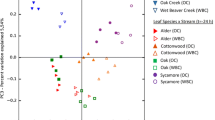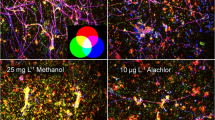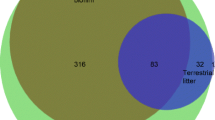Abstract
Dissolved organic matter in the form of leaf leachate represents an important carbon and energy source in many lotic ecosystems. In this study, we investigated utilization of mono-specific and mixed-species leaf leachate and impacts on biofilm bacterial community structure. Ceramic tiles were incubated in a Northeast Ohio stream to allow for biofilm development and then exposed in the laboratory to glucose or leachate from: sugar maple (Acer saccharum), pin oak (Quercus palustris), maple + oak, American beech (Fagus grandifolia), witch hazel (Hamamelis virginiana), or beech + witch hazel. Bacterial responses to these amendments were compared to un-amended controls based on fluorescent in situ hybridization (FISH) targeting selected taxa and terminal restriction fragment length polymorphism (T-RFLP) of bacterial 16S rRNA genes; also changes in DOC concentrations were quantified. Generally, there were limited differences among communities as a result of leachate amendment, although specific taxa monitored by FISH exhibited differential responses. There was no evidence that mixing of leachate from different leaf species created an effect different than what could be expected based on monospecific experiments. Witch hazel solicited the greatest response, based on T-RFLP data, regardless of whether the community was exposed to witch hazel alone or witch hazel + beech, accounting for 19% of the variability in Jaccard distance (P < 0.05) and 27% of the variability in Hellinger distance among profiles. In conclusion, we found that leaf leachate can be readily degraded but only in some cases did differences in leaf leachate among tree species cause an alteration in community structure. Mixing of leachate from different leaf species did have an impact on DOC loss but did not alter community structure. The occurrence of particular compounds, such as those in witch hazel, may alter community structure suggesting that the presence and abundance of specific plant taxa can impact bacterial communities.






Similar content being viewed by others
References
Amann, R. I., L. Krumholz & D. A. Stahl, 1990. Fluorescent-oligonucleotide probing of whole cells for determinative phylogenetic and environmental studies in microbiology. Journal of Bacteriology 172: 762–770.
Amann, R. I., W. Ludwig & K. H. Schleifer, 1995. Phylogenetic identification and in situ detection of individual microbial cells without cultivation. Microbiology and Molecular Biology Reviews 59: 143–169.
APHA (American Public Heath Association), 1998. Standard Methods for the Examination of Water and Wastewater, 20th ed. American Public Health Association, Washington, DC.
Araya, R., K. Tanik, T. Takagi, N. Tamaguchi & M. Nasu, 2003. Bacterial activity and community composition in stream water and biofilms from an urban river determined by fluorescent in situ hybridization and DGGE analysis. FEMS Microbiology Ecology 43: 111–119.
Battin, T. J., L. A. Kapian, J. D. Newbold & C. M. E. Hansen, 2003. Contributions of microbial biofilms to ecosystem processed in stream mesocosms. Nature 426: 439–442.
Blackwood, C. B. & J. S. Buyer, 2007. Evaluating the physical capture method of terminal restriction fragment length polymorphism for comparison of soil microbial communities. Soil Biology and Biochemistry 39: 590–599.
Blackwood, C. B., A. Oaks & J. S. Buyer, 2005. Phylum- and class-specific PCR primers for general microbial community analysis. Applied and Environmental Microbiology 71: 6193–6198.
Blackwood, C. B., C. J. Dell, A. J. M. Smucker & E. A. Paul, 2006. Eubacterial communities in soil macroaggregate environments and cropping systems. Soil Biology and Biochemistry 38: 720–728.
Bouvier, T. & P. A. Giorgio, 2003. Factors influencing the detection of bacterial cells using fluorescence in situ hybridization (FISH): a quantitative review of published reports. FEMS Microbiology Ecology 44: 3–15.
Chappelle, F. H., 1993. Ground-Water Microbiology and Geochemistry. Wiley, New York.
Cleveland, C. C., J. C. Neff, A. R. Townsend & E. Hood, 2004. Composition, dynamics, and fate of leached dissolved organic matter in terrestrial ecosystems: results from a decomposition experiment. Ecosystems 7: 275–285.
Cos, P., T. D. Bruyne, N. Hermans, S. Apers, D. V. Berghe & A. J. Vlietinck, 2004. Proanthocyanidins in health care: current and new trends. Current medicinal chemistry 11: 1345–1359.
Cottrell, N. T. & D. L. Kirchman, 2000. Natural assemblages of marine proteobacteria and members of the Cytophaga-Flavobacter cluster consuming low- and high-molecular-weight dissolved organic matter. Applied and Environmental Microbiology 66: 1692–1697.
Danovaro, R., G. M. Luna, A. D. Anno & B. Pietrangeli, 2006. Comparison of two fingerprinting techniques, terminal restriction fragment length polymorphism and automated ribosomal intergenic spacer analysis, for determination of bacterial diversity in aquatic environments. Applied and Environmental Microbiology 72: 5982–5989.
DeLong, E. F., G. S. Wickham & N. R. Pace, 1989. Phylogenetic stains: ribosomal RNA-based probes for the identification of single cells. Science 243: 1360–1363.
Docherty, K. M., K. C. Young, P. A. Maurice & S. D. Bridgham, 2006. Dissolved organic matter concentration and quality influences upon structure and function of freshwater microbial communities. Microbial Ecology 52: 378–388.
Dubois, M., D. A. Gilles, J. K. Hamilton, P. A. Rebers & F. Smith, 1956. Colorimetric method for the determination of sugars and related substances. Analytical Chemistry 28: 350–356.
Egli, T., 1995. The ecological and physiological significance of the growth of heterotrophic microorganisms with mixtures of substrates. In Jones, J. G. (ed.), Advances in Microbial Ecology. Plenum press, New York: 305–386.
Eiler, A., S. Langenheder, S. Bertilsson & L. Tranvik, 2003. Heterotrophic bacterial growth efficiency and community structure at different natural organic concentrations. Applied and Environmental Microbiology 69: 3701–3709.
Farjalla, V. F., D. A. Azevedo, F. A. Esteves, R. L. Bozelli, F. Roland & A. Enrich-Prast, 2006. Influence of hydrological pulse on bacterial growth and DOC uptake in a Clear-Water Amazonian Lake. Microbial Ecology 52: 334–344.
Fierer, N., J. P. Schimel, R. G. Cats & J. Zou, 2001. Influence of balsam popular tannin fractions on carbon and nitrogen dynamics in Alaskan taiga floodplain soils. Soil Biology and Biochemistry 33: 1827–1839.
Fisher, S. G. & G. E. Likens, 1973. Energy flow in Bear Brook. New Hampshire: an integrative approach to stream ecosystem metabolism. Ecological monographs 43: 421–439.
Giller, P. & B. Malmqvist, 1998. The Biology of Rivers and Streams. Oxford University Press, Oxford.
Gurung, T. B. & J. Urabe, 1999. Temporal and vertical difference in factors limiting growth rate of heterotrophic bacteria in Lake Biwa. Microbial Ecology 38: 136–145.
Hall, J. R., 1995. Use of a stable carbon isotope addition to trace bacterial carbon through a stream food web. Journal of the North American Benthological Society 14: 269–277.
Juni, E., 1978. Genetics and physiology of Acinetobacter. Annual Reviews in Microbiology 32: 349–371.
Kent, A. D., D. J. Smith, B. J. Benson & E. W. Triplett, 2003. Web-based phylogenetic assignment tool for analysis of terminal restriction fragment length polymorphism profiles of microbial communities. Applied and Environmental Microbiology 69: 6768–6776.
Koetsier, P., J. V. McArthur & L. G. Leff, 1997. Spatial and temporal response of stream bacteria to sources of dissolved organic carbon in a blackwater stream system. Freshwater Biology 37: 79–89.
Leff, L. G., 2000. Longitudinal changes in microbial assemblages of the Ogeechee River. Freshwater Biology 43: 605–615.
Legendre, P. & M. J. Anderson, 1999. Distance-based redundancy multifacturial analysis: testing multispecies responses in ecological experiments. Ecological Monographs 69: 1–24.
Legendre, P. & E. D. Gallagher, 2001. Ecologically meaningful transformation for ordination of species data. Oecologia 129: 271–280.
Lessie, T. G. & T. Gaffney, 1986. Catabolic potential of Pseudomonas cepacia. In Sokatch, J. R. (ed.), The Bacteria: A Treatise on Structure and Function. Academic Press, New York: 439–481.
Liu, J. & L. G. Leff, 2002. Temporal changes in the bacterioplankton of a Northeast Ohio (USA) river. Hydrobiologia 489: 151–159.
Liu, W. T., T. L. Marsh, H. Cheng & L. J. Forney, 1997. Characterization of microbial diversity by determining terminal restriction fragment length polymorphisms of genes encoding 16S rRNA. Applied and Environmental Microbiology 63: 4516–4522.
Manz, W., K. Wedt-Potthoff, T. R. Neu, U. Szewzyk & J. R. Lawrence, 1999. Phylogenetic composition, spatial structure, and dynamics of lotic bacterial biofilms investigated by flucorescent in situ hybridization and confocal laser scanning microscopy. Microbial Ecology 37: 225–237.
Marsh, T. L., 1999. Terminal-restriction fragment length polymorphism (T-RFLP): an emerging method for characterizing diversity among homologous populations of amplicons. Current Opinion in Microbiology 2: 323–327.
McArthur, J. V. & G. R. Marzolf, 1986. Interactions of the bacterial assemblages of a prairie stream with dissolved organic carbon from riparian vegetation. Hydrobiologia 134: 193–199.
McArthur, J. V., J. M. Aho, R. B. Rader & G. L. Mills, 1994. Interspecific leaf interactions during decomposition in aquatic and floodplain ecosystems. Journal of the North American Benthological Society 13: 57–67.
McNamara, C. J. & L. G. Leff, 2004a. Response of biofilm bacteria to dissolved organic matter from decomposing maple leaves. Microbial Ecology 48: 324–330.
McNamara, C. J. & L. G. Leff, 2004b. Bacterial community composition in biofilms on leaves in a northeastern Ohio stream. Journal of the North American Benthological Society 23: 677–685.
Meyer, J. L., 1994. The microbial loop in flowing waters. Microbial Ecology 28: 195–199.
Mulholland, P. J., J. W. Elwood, J. D. Newbold, J. R. Webster, L. A. Ferren & R. E. Perkins, 1984. Phosphorus uptake by decomposing leaf detritus: effect of microbial biomass and activity. Verhandlung Internationale Vereinigung Limnologie 22: 1899–1905.
Münster, U., 1993. Concentrations and fluxes of organic carbon substrates in the aquatic environment. Antonie van Leeuwenhoek 63: 243–274.
Olapade, O. A. & L. G. Leff, 2004. Seasonal dynamics of bacterial assemblages in epilithic biofilms in a northeastern Ohio stream. Journal of the North American Benthological Society 23: 687–700.
Olapade, O. A. & L. G. Leff, 2005. Seasonal response of stream biofilm communities to dissolved organic matter and nutrient enrichments. Applied and Environmental Microbiology 71: 2278–2287.
Olapade, O. A. & L. G. Leff, 2006. Influence of dissolved organic matter and inorganic nutrients on biofilm bacterial community on artificial substrates in a north-eastern Ohio stream (USA). Canadian Journal of Microbiology 52: 540–549.
Pernthaler, J., O. F. Glöckner, A. A. Unterholzner, R. Psenner & R. Amann, 1998. Seasonal community and population dynamics of pelagic bacteria and archaea in a high mountain lake. Applied and Environmental Microbiology 64: 4299–4306.
Porter, K. S. & Y. S. Feig, 1980. The use of DAPI for identifying and counting aquatic microflora. Limnology and Oceanography 25: 943–948.
Rubin, M. A. & L. G. Leff, 2007. Nutrients and other abiotic factors affecting bacterial communities in an Ohio River (USA). Microbial Ecology 54: 374–383.
Santmire, J. A. & L. G. Leff, 2007. The influence of stream sediment particular size on bacterial abundance and community composition. Aquatic Ecology 41: 153–160.
Sasaki, A., S. Shikenya & K. Takeda, 2007. Dissolved organic matter originating from the riparian shrub Salix gracilistyla. Journal of Forest Research 12: 68–74.
Schlief, J. & M. Mutz, 2007. Response of aquatic leaf associated microbial communities to elevated leachate DOC: a microcosm study. International Review of Hydrobiology 92: 146–155.
Singleton, V. L. & J. A. Rossi, 1965. Colorimetry of total phenolics with phosphomolybdic–phosphotungstic acid reagents. American Journal of Enology and Viticulture 16: 144–158.
Skoog, A., K. Whitehead, F. Sperling & K. Junge, 2002. Microbial glucose uptake and growth along a horizontal nutrient gradient in the North Pacific. Limnology and Oceanography 47: 1676–1683.
Strauss, E. A. & G. A. Lamberti, 2002. Effect of dissolved organic carbon quality on microbial decomposition and nitrification rates in stream sediments. Freshwater Biology 47: 65–74.
Sun, L., E. M. Perdue, J. L. Meyer & J. Weis, 1997. Use of elemental composition to predict bioavailability of dissolved organic matter in a Georgia river. Limnology and Oceanography 42: 714–721.
Tourino, S., D. Lizarraga, S. Lorenzo, V. Ugartondo, M. Mitjans, M. P. Vinardell, L. Juliá, M. Cascante & J. L. Torres, 2008. Highly galloylated tannin fractions from witch hazel (Hamamelis virginiana) bark: electron transfer capacity, in vitro antioxidant activity, and effects on skin-related cells. Chemical Research in Toxicology 21: 696–704.
Wallace, T. A., G. G. Ganf & J. D. Brookes, 2008. A comparison of phosphorus and DOC leachates from different types of leaf litter in an urban environment. Freshwater Biology 53: 1902–1913.
Webster, J. R. & E. F. Benfield, 1986. Vascular plant breakdown in freshwater ecosystems. Annual Review of Ecology and Systematics 17: 567–594.
Webster, J. R., J. B. Wallace & E. F. Benfield, 1995. Organic processes in streams of the eastern united states. In Cushing, C. E., K. W. Cummins & G. W. Minshall (eds), River and Stream Ecosystems. Elsevier Science BV, Amsterdam: 117–187.
Wehr, J. D., J. Petersen & S. Findlay, 1999. Influence of three contrasting detrital carbon sources on planktonic bacterial metabolism in a mesotrophic lake. Microbial Ecology 37: 23–35.
Wetzel, R. G., 1992. Gradient dominated ecosystems: sources and regulatory functions of dissolved organic matter in freshwater ecosystems. Hydrobiologia 229: 181–198.
Acknowledgments
We are grateful to C. Clevinger, R. Vukanti, and L. Feinstein for their assistance and financial support from China scholarship fund (2006A62008).
Author information
Authors and Affiliations
Corresponding author
Additional information
Handling editor: L. Naselli-Flores
Electronic supplementary material
Rights and permissions
About this article
Cite this article
Wu, L., Blackwood, C.B. & Leff, L.G. Effect of single-species and mixed-species leaf leachate on bacterial communities in biofilms. Hydrobiologia 636, 65–76 (2009). https://doi.org/10.1007/s10750-009-9935-1
Received:
Revised:
Accepted:
Published:
Issue Date:
DOI: https://doi.org/10.1007/s10750-009-9935-1




